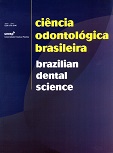Influência do tempo de armazenamento na resistência de união à dentina de dois
DOI:
https://doi.org/10.14295/bds.2003.v6i4.577Abstract
O objetivo da pesquisa foi estudar a influência do tempo de armazenamento (24h e três meses) na resistênciaadesiva de dois tipos de adesivo dental, sendo um convencional, Single Bond (SB) e outro com primer autocondicionante,
ABF experimental (ABF), e também a influência das variações regionais do substrato dentinário. O
esmalte oclusal de 16 terceiros molares foi removido, expondo uma superfície dentinária plana. Nesta, foi criada
uma camada de smear através de lixas de papel de granulações decrescentes. Após a aplicação dos sistemas
adesivos, blocos de resina Z250 de 5 mm de altura foram construídos sobre a superfície dentinária. Os dentes
foram divididos em quatro grupos (n=4) de acordo com o material e o tempo de armazenagem em água destilada
a 37∞C: A)SB 24 h; B)SB três meses; C)ABF 24 h; D)ABF três meses. Após o armazenamento, os dentes foram
seccionados, longitudinalmente, em cortes perpendiculares entre si, a fim de se obterem corpos-de-prova (cp)
em formato de palito de aproximadamente 0,8 mm2 de secção transversal, constituídos por resina-adesivo-dentina.
Esses cp foram mapeados, com esmaltes de diferentes cores, conforme suas localizações no dente: mais
periférica ou interna, no sentido horizontal. Os espécimes foram submetidos ao teste de microtração. A análise
de variância demonstrou não haver diferença significante entre os valores médios de resistência dos dois adesivos
com diferentes idades de armazenamento, nem entre as diferentes regiões do dente.
Downloads
Downloads
Published
How to Cite
Issue
Section
License
Brazilian Dental Science uses the Creative Commons (CC-BY 4.0) license, thus preserving the integrity of articles in an open access environment. The journal allows the author to retain publishing rights without restrictions.
=================




























